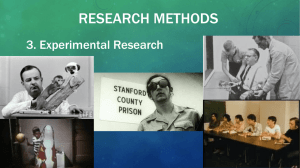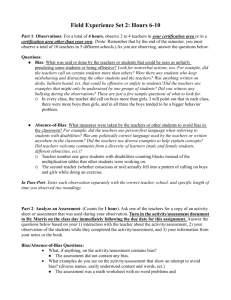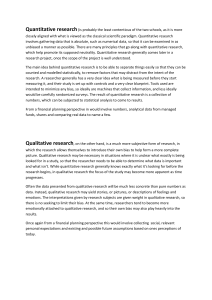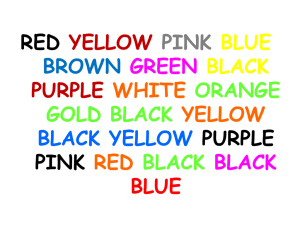Psychology Research Methods: Experiments, Surveys, & More
advertisement
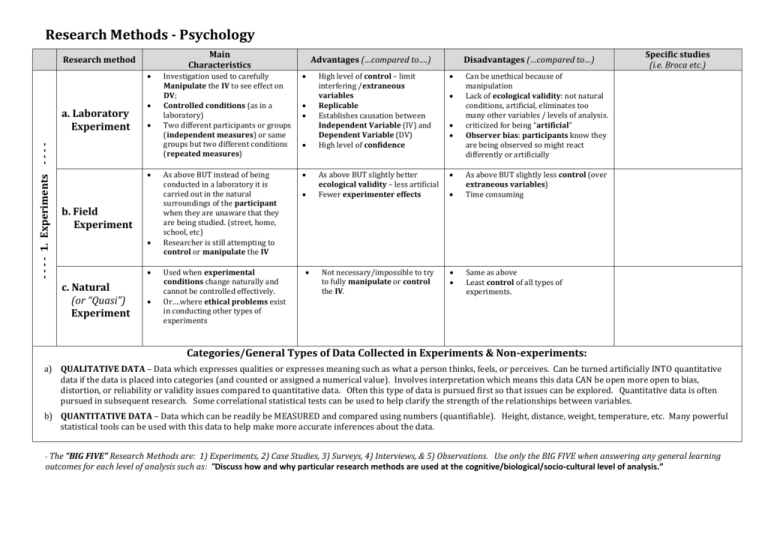
Research Methods - Psychology Main Characteristics Research method - - - - 1. Experiments - - - - a. Laboratory Experiment b. Field Experiment c. Natural (or “Quasi”) Experiment Advantages (…compared to….) Investigation used to carefully Manipulate the IV to see effect on DV; Controlled conditions (as in a laboratory) Two different participants or groups (independent measures) or same groups but two different conditions (repeated measures) As above BUT instead of being conducted in a laboratory it is carried out in the natural surroundings of the participant when they are unaware that they are being studied. (street, home, school, etc) Researcher is still attempting to control or manipulate the IV Used when experimental conditions change naturally and cannot be controlled effectively. Or….where ethical problems exist in conducting other types of experiments Disadvantages (…compared to…) High level of control – limit interfering /extraneous variables Replicable Establishes causation between Independent Variable (IV) and Dependent Variable (DV) High level of confidence As above BUT slightly better ecological validity – less artificial Fewer experimenter effects Not necessary/impossible to try to fully manipulate or control the IV. Specific studies (i.e. Broca etc.) Can be unethical because of manipulation Lack of ecological validity: not natural conditions, artificial, eliminates too many other variables / levels of analysis. criticized for being “artificial” Observer bias: participants know they are being observed so might react differently or artificially As above BUT slightly less control (over extraneous variables) Time consuming Same as above Least control of all types of experiments. Categories/General Types of Data Collected in Experiments & Non-experiments: a) QUALITATIVE DATA – Data which expresses qualities or expresses meaning such as what a person thinks, feels, or perceives. Can be turned artificially INTO quantitative data if the data is placed into categories (and counted or assigned a numerical value). Involves interpretation which means this data CAN be open more open to bias, distortion, or reliability or validity issues compared to quantitative data. Often this type of data is pursued first so that issues can be explored. Quantitative data is often pursued in subsequent research. Some correlational statistical tests can be used to help clarify the strength of the relationships between variables. b) QUANTITATIVE DATA – Data which can be readily be MEASURED and compared using numbers (quantifiable). Height, distance, weight, temperature, etc. Many powerful statistical tools can be used with this data to help make more accurate inferences about the data. - The “BIG FIVE” Research Methods are: 1) Experiments, 2) Case Studies, 3) Surveys, 4) Interviews, & 5) Observations. Use only the BIG FIVE when answering any general learning outcomes for each level of analysis such as: “Discuss how and why particular research methods are used at the cognitive/biological/socio-cultural level of analysis.” Main Characteristics Research method Correlational study Disadvantages (…compared to…) Not a research method but a description of the kind of relationship between variables that is being pursued. Any type of study whose predetermined purpose is to try to establish a correlation (link) between two factors or variables. Used when experiments are impossible or unethical Focused on one link or trend Usually no artificial manipulation Can support prior research or basis for further research (good starting point for further research) Can be reductionist Does not establish causation: not 100% sure one factor causes the other Bi-directional ambiguity: not sure which factor causes the other or how the factors move in relation to one another Gathering data on one specific subject, usually used for rare conditions or situations Longitudinal, lots of data, quality of data, perhaps less reductionist Provides rich data 2. Case study 3. Observation (non-participant; participant; covert/undisclosed; overt/disclosed) Good when studying behavior for first time – help to establish possible relationships 4. Survey (questionnaires) 5. Interview Realistic behavior can be observed (high ecological validity) Good for young children ---- Non-Experiments - - - - (twin studies, family studies etc.) Advantages (…compared to….) Type of self-report in which participants provide data by answering questions – orally or in written form. Usually qualitative but sometimes quantitative data Types of survey questions: Open-ended OR closed Gathering information using prepared questions and recording answers. Usually qualitative data interpreted by researcher Types: face to face, by telephone, or email Format: Structured, unstructured, semi-structured Good for situations where lots of data needed in a reasonably short amount of time Good for studying variables for the first time. Rich data Possibility for clarification questions if conducted face to face or over telephone Can provide flexibility (unstructured format) for the researcher Ethical problems: years of study on one person, not always clear consent Cannot establish cause and effect Hard to generalize from - as very abnormal and only one case Cannot replicate Not possible to know cause and effect relationship Difficult to replicate Difficult to control extraneous variables Difficult to avoid observer bias Many problems with self-reporting (response bias, participant bias, etc) No cause and effect relationship can be determined Common for questions to be unreliable – (to have several meanings depending on who is answering them) Subjective interpretation by interviewer No cause and effect relationships can be determined Specific studies (i.e. Speissman, etc.)
